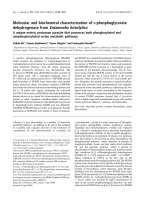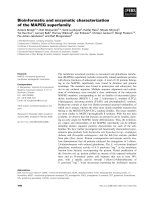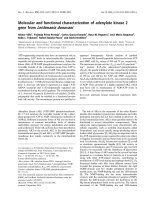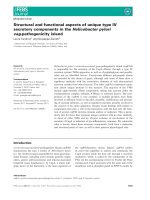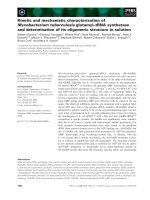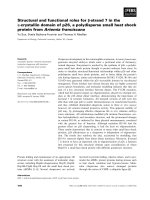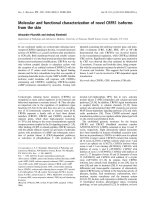Báo cáo khoa học: Molecular and functional characterization of novel CRFR1 isoforms from the skin pptx
Bạn đang xem bản rút gọn của tài liệu. Xem và tải ngay bản đầy đủ của tài liệu tại đây (474.96 KB, 10 trang )
Molecular and functional characterization of novel CRFR1 isoforms
from the skin
Alexander Pisarchik and Andrzej Slominski
Department of Pathology and Laboratory Medicine, University of Tennessee Health Science Center, Memphis, TN, USA
In our continued studies on corticotropin releasing factor
receptor (CRFR1) signaling in the skin, we tested functional
activity of CRFR1a, e, f, g and h isoforms after transfection
to COS cells. Both membrane-bound and soluble variants
are translated in vivo into final protein products that undergo
further post-translational modifications. CRFR1a was the
only isoform coupled directly to adenylate cyclase with
the exception of an artificial isoform (CRFR1h2) with the
insertion of 37 amino acids between the ligand binding
domain and the first extracellular loop that was capable of
producing detectable levels of cyclic AMP (cAMP). Soluble
isoforms could modulate cell response with CRFR1e
attenuating and CRFR1h amplifying CRFR1a-coupled
cAMP production stimulated by urocortin. Testing with
plasmids containing the luciferase reporter gene, and indu-
cible cis-elements (CRE, CaRE, SRE, AP1 or NF-jB)
demonstrated that only CRFR1a was involved directly
in the transcriptional regulation, while CRFR1g inhibited
CRE activity. Significantly higher reporter gene expression
by CRF was observed than that mediated by 4b-phorbol
12-myristate 13-acetate and forskolin alone, being compat-
ible with the concomitant treatment by phorbol 12-myristate
13-acetate and forskolin. This suggests that both protein
kinase A and C can be involved in CRF-dependent signal
transduction.
Keywords: skin; CRFR1; CRF; urocortin; COS cells.
Corticotropin releasing factor receptors (CRFRs) are
recognized as main central regulators in the humoral and
behavioral responses to systemic stress [1–4]. They also play
an important role in the regulation of peripheral organ
functions [2,3,5,6]. In the skin they may serve as coordina-
tors of its homeostatic response to external stress [6–8].
CRFRs represent a family with at least three distinct
members (CRFR1, CRFR2 and CRFR3) encoded by
separate genes, which share high-sequence homology
( 70%) and belong to the seven transmembrane segment
receptor proteins coupled to the Gs signaling system [1–3,9].
After binding of CRF or related peptides, CRFR1 interacts
with the cellular effectors system via activation of adenylate
cyclase with production of cAMP and subsequent activa-
tion of protein kinase A (PKA)-dependent pathways;
or activation of phospholipase C with production of
inositol-1,4,5-triphosphate (IP3); this in turn, activates
protein kinase C (PKC)-dependent and calcium-activated
pathways [2,9,10]. In addition, CRFR1 signal transduction
is coupled directly to calcium channels [11,12]. Some
authors also demonstrated that CRF receptors can activate
MAP kinase-dependent signaling pathways [13] and nitric
oxide production [14]. These CRFR1-activated signal
transduction pathways can regulate cellular phenotype both
on the central and peripheral levels.
The established genomic structures for the human
CRFR1 and CRFR2 (GenBank accession number
AF039510-AF3523; L24096) contained at least 14 and 15
exons, respectively. Eight alternatively spliced transcripts
have been identified in humans (GenBank accession num-
bers are in parentheses); CRFR1a in which exon 6 is spliced
(L23332); a longer variant CRFR1b (variant) that contains
all 14 exons (L23333); CRFR1c isoform where exon 3 and
exon 6 are spliced out (U16273); CRFR1d isoform where
exons 6 and 13 are missing (AF180301); CRH-R1e with
deletion of exons 3 and 4 (AF369651); CRFR1f with
deletion of exon 12 (AF369652); CRFR1g with deletion of
exon 11, 27 basepairs of exon 10 and 28 basepairs of exon
12 (AF369653); and CRFR1h with addition of a cryptic
exon (AF374231) [15–18]. In rodents, three CRFR1
isoforms have already been identified in rats [19], four in
mice [18] and nine in hamsters [20]. It was proposed that
differential and tissue-specific expression of alternatively
spliced CRFR forms are linked to the functional activity of
placenta, decidua, fetal membranes, endometrium, myo-
metrium, uterine vasculature and the immune system
[2,16,21,22]. In skin, such expression is defined by anatomic
or histological location, physiological status, coexisting
pathology, or hair cycle phase [18,23]. In addition, we have
Correspondence to A. T. Slominski, Department of Pathology and
Laboratory Medicine, 930 Madison Avenue, Room 519, Memphis,
TN 38163, USA. Fax: + 1 901 4486979,
Tel.: + 1 901 4483741, E-mail:
Abbreviations: AEBSF, amino-ethyl benzene sulfonyl fluoride; cAMP,
cyclic AMP; CaRE, calcium responsive element; CMV, cytomegalo-
virus; CRE, cyclic AMP responsive element; CREB, cyclic AMP
responsive element binding protein; CRF, corticotropin releasing
factor; CRFR1, corticotropin releasing factor receptor; IP3, inositol-
1,4,5-triphosphate; NF-jB, nuclear factor-kappa B; PKA, protein
kinase A; PKC, protein kinase C; PMA, 4b-phorbol 12-myristate
13-acetate; SRE, serum responsive element; TSH, thyroid stimulating
hormone.
(Received 24 March 2004, revised 30 April 2004, accepted 13 May
2004)
Eur. J. Biochem. 271, 2821–2830 (2004) Ó FEBS 2004 doi:10.1111/j.1432-1033.2004.04216.x
demonstrated that alternative splicing of CRFR1 is modu-
lated by external factors such as ultraviolet radiation or
exposure to forskolin or 4b-phorbol 12-myristate 13-acetate
(PMA) [18]. The above findings raise the question about the
significance of generation of alternatively spliced CRFR1
mRNA forms. In general, the importance of alternative
splicing is emphasized by the fact that up to 50% of human
genes may be alternatively spliced, that this mechanism is
frequently deregulated in cancer cells and that environmen-
tal factors can modulate the splicing process [18,24].
CRFR1 a, b, c and d isoforms differ in their ability to
bind ligands and activate G proteins [10,16,25]. CRFR1a is
the most efficient in the stimulation of cAMP production,
CRFR1c and CRFR1b have a decreased CRF binding
capacity [10,25], while CRFR1d is poorly coupled to G
proteins [16].
Recently we have described four new human CRFR1
isoforms, which included messages with internal deletions
and unusual isoforms composed of soluble extracellular
(ligand-binding) domains [18]. As the skin shows poly-
morphism in CRFR1 expression and its functional diversity
may require differential expression of isoforms of CRFR1
to precisely couple selectively activated phenotypic targets,
we performed molecular characterization of newly described
CRFR1 isoforms. First, we tested whether these messages
are translatable. In the second step, we characterized their
coupling to different signaling pathways and their modu-
latory role on the CRFR1a activity.
Materials and methods
CRFR1 constructs preparations
Full-length sequences of human CRFR1 isoforms were
constructed by PCR. Plasmid phCRFR82 (generous gift of
Dr N. Vita, Sanofi Recherche, Labege, France) containing
human CRFR1a cDNA was used as an initial template.
The reaction mixture (25 lL) contained 2 m
M
MgCl
2
,2.5of
each dNTP, 0.4 l
M
of each primer, 20 m
M
Tris/HCl
(pH 8.8), 10 m
M
KCl, 10 m
M
(NH
4
)
2
SO
4
, 0.1% Triton
X-100, 0.1 mgÆmL
)1
bovine serum albumin and 1.25 l of
Pfu DNA polymerase (Stratagen, La Jolla, CA, USA). The
mixture was heated to 95 °C for 2.5 min and then amplified
for 25 cycles: 94 °C for 30 s (denaturation), 56 °Cfor40s
(annealing) and 72 °C for 1.5 min (extension).
CRFR1a was amplified from phCRFR82 plasmid
by primers E3 (5¢-AAAAGCTTAGGACCCGGGCATTC
AGGA-3¢)andE11(5¢-AAGAATTCTCAGACTGCTGT
GGACTGCT-3¢).
Full-length CRFR1g DNA was obtained in three PCR
reactions. First, a fragment spanning 5¢ untranslated
sequence and exons 1 through 10 was amplified by primers
E3 and E9 (5¢-GAAGGAGTTGAAGTAGATGTAG
TCGGTGTACA-3¢). Second fragment (exons 12–14) was
amplified by primers E12 (5¢-CATCTACTTCAACT
CCTTCCTG-3¢) and E11. Finally, the first two fragments
were assembled together by primers E3 and E11. This was
possible because primer E9 contained a sequence homolog-
ous to primer E12.
Similarly, for CRFR1f construct exons 1–11 of CRF
receptor were amplified by primers E3 and E18 (5¢-AC
AAAGAAGCCCTGTACTGAATGGTCTCAG-3¢), and
exons 13 and 14 by primers E16 (5¢-CATTCAGTAC
AGGGCTTCTTTGTGTCTGTG-3¢)andE17(5¢-AA
GAATTCTCATCCCCCCAGCCACAG-3¢). The full se-
quence was obtained by combining those two fragments
together by primers E3 and E17.
CRFR1e DNA was constructed in a slightly different
manner. Fragments spanning exons 1–2 and 5–14 were
amplified by primers E3, E26 (5¢-CTTGCTTTTTTTGA
GATGTTGCTGGCCAGGGA-3¢)andE25(5¢-AAAAA
AAGCAAGGTGCACTACC-3¢), E11, respectively. The
first fragment was slightly extended in nested PCR by
primers E3 and E28 (5¢-TGGTAGTGCACCTTGCTTT
TTTTGAGATGTTGC-3¢). Finally, full-length CRFR1e
DNA was assembled by PCR of these two fragments with
primers E3 and E11.
Two different constructs were produced for CRFR1h
isoform. The first contained exons 1–4 and a fragment of the
cryptic exon up to the translation terminator. These
constructs were also assembled in three steps. In the first
PCRweamplifiedexons1–4byprimersE3andE24
(5¢-CTCCTCATTGAGGATCTCCT-3¢). The second PCR
amplified the cryptic exon by primers E21 (5¢-GTG
CCAGGAGATCCTCAATG-3¢)andE19(5¢-AA
GAATTCTTTGTCCCACCACGGTGTGCTC-3¢). The
third PCR assembled the CRFR1h DNA. Another con-
struct (CRFR1h2) was designed to contain an in-frame
insertion of the cryptic exon. It was produced by six separate
amplifications. First PCR amplified exons 1–4 by primers
E3 and E24. The second one produced a fragment spanning
exons 5–14 (primers E25, E11). The first half of the cryptic
exon was amplified by primers E21 and E20
(5¢-TGATGTCCCACCACGGTGTG-3¢). The second half
was amplified by primers E22 (5¢-GTGGGACATCAAA
ACGGATTCTGGGGGTCTG-3¢)andE23(5¢-CTTGC
TTTTTTTCTCTCCCCACACGGTGAAC-3¢). Primers
E20 and E22 contained two mutations eliminating transla-
tion terminator and introducing additional nucleotide to
preserve translation frame of CRF receptor. The mutated
fragment was reassembled by primers E21 and E23 and
connected to CRFR1 (exons 1–4) by primers E3 and E23.
This fragment was slightly extended by primer E27
(5¢-GGTAGTGCACCTTGCTTTTTTTCTCTCCCCA-
3¢) and attached to another fragment of CRF receptor in the
final PCR by primers E3 and E11.
To attach V5 epitope to the CRFR1a,g,h2ande2
isoforms we amplified the corresponding DNA fragments
with primers E3 and primer E29 (5¢-AAGAATTCTTG
ACTGCTGTGGACTGCT-3¢). Isoform CRFR1f was
amplified with primers E3 and primer E30 (5¢-AAGA
ATTCTTTCCCCCCAGCCACAG-3¢) and CRFR1e with
primers E3 and primer E31 (5¢-AAGAATTCTTGCT
GGACCACGAACCAGGT-3¢).
Final PCR fragments were purified by GFX gel band
purification kit (Amersham-Pharmacia-Biotech), digested
by HindIII and EcoRI enzymes and cloned in expression
vector pcDNA6/V5-His version B (Invitrogen, Carlstand,
CA, USA).
Luciferase constructs
The starting vector to construct luciferase (luc) reporter gene
plasmids was pGL3-basic (Promega). We had to modify the
2822 A. Pisarchik and A. Slominski (Eur. J. Biochem. 271) Ó FEBS 2004
promoter region to insert TATA box and convenient
restriction sites. Thus, we deleted the luciferase gene by
amplification pGL3-basic with P762 (5¢-TCGAATTCCC
TAGGGCCGCTTCGAGCAGACATGA-3¢) and P763
(5¢-TTCTCGAGACGCGTTATCGATAGAGAAATGT
TCTGGC-3¢) and digested the PCR product with EcoRI
and XhoI. The insert was synthesized with primers P764
(5¢-AACTCGAGGCTAGTCTGCAGGAGCTCAAGCT
TTCTAGAGAATTCA-3¢)andP765(5¢-TGAATTCTC
TAGAAAGCTTGAGCTCCTGCAGACTAGCCTCGA
GTT-3¢). It was also digested with EcoRI and XhoI, ligated
withthevectorandclonedinJM109Escherichia coli.
Luciferase gene was amplified from pGL3-basic vector by
primers P766 (5¢-AAAAGCTTCCCGGGCATTCCGGT
ACTGTTGGTAAA-3¢), P767 (5¢-GGGAATTCGACTC
TAGAATTACACGGCGA-3¢), digested with HindIII and
EcoRI and inserted in the vector described above. This
plasmid was named pLuc.
The minimal promoter containing TATA box was
amplified from pcDNA6/V5-HisA vector (Invitrogen) by
primers P768 (5¢-AACTGCAGGAGCTCCCCATTG
ACGCAAATGGGCG-3¢), P769 (5¢-GGAAGCTTTTC
GATAAGCCAGTAAGCAGTG-3¢), digested with PstI
and HindIII and inserted in pLuc. This plasmid was named
pP1-Luc.
pP1-Luc was used to construct the reporter plasmids
containing CRE, CaRe, NF-jB, AP1, SRE sequences.
These sequences were synthesized as 45 basepair-long
oligonucleotides and assembled in 158 basepair-long frag-
ments according the reported protocols [26]. Assembled
fragments were digested by XhoI, PstI and inserted in
pP1-Luc.
In summary, the newly produced constructs were as
follows: pCRE-Luc (contained four CRE elements);
pCaRe-Luc (four CaRe elements); pAP1-Luc (fiive AP1
elements); pSRE-luc (two SRE elements); pNF-jB-Luc
(four pNF-jB elements) pNF-jB-Luc2 (two pNF-jB
sequences). pL-Luc served as negative control. It contained
158 basepair-long random sequence. The positive control
was pCMV-luc. It contained CMV promoter. The
sequences of the cis elements were as follow: CRE
(5¢-TGACGTCA-3¢), CaRE (5¢-TGACGTTT-3¢), NF-jB
(5¢-GGGGACTTTCC-3¢), AP1 (5¢-TGACTAA-3¢), SRE
(5¢-CCATATTAGG-3¢).
Transfections of COS cells with the plasmids
For transfection we used 4000 cells per well of 96-well
plate. Cells were washed with antibiotic-free Dulbecco’s
modified Eagle’s media (DMEM) and transfected by
constructs using Lipophectamine Plus reagent (Invitrogen,
Carlstand, CA, USA) according to the manufacturers’
protocol. We always used equal amount of plasmid DNA
in each experiment (0.1 lgÆwell
)1
). Plasmid pcDNA6/V5-
His version B (further named as pcDNA) was used as an
empty vector. Four hours after transfection an equal
volume of DMEM media containing 10% fetal bovine
serum was added and cells were incubated overnight. Next
morning, the cells were washed by DMEM and incubated
in DMEM media containing 5% fetal bovine serum and
antibiotics for 24 h. After that cells were stimulated by
CRF or urocortin.
Western blotting
Transfected cells were detached by trypsin, centrifuged at
1000 g for 10 min at 4 °C. The cell pellets were then washed
with NaCl/P
i
and frozen in )70 C. For protein isolation
frozen cell pellets were solubilized by pipetting into an iced
buffer containing 20 m
M
Tris, pH 7.5, 150 m
M
NaCl, 15%
glycerol, 1% Triton X100, 120 lgÆmL
)1
leupeptin, 3 l
M
pepstatin and 3 m
M
amino-ethyl benzene sulfonyl fluoride
(AEBSF). Cellular homogenates were centrifuged at
16 000 g for 10 min at 4 °C, and the supernatants were
removed and stored at )80 °C for further analysis. Separate
aliquots of 5 lL were used for protein determination by
Micro protein Kit (Sigma). Fifty micrograms of protein
were loaded on 12% SDS-PAGE, transferred to immobi-
lion-p poly(vinylidene difluoride) membrane (Millipore
Corp, Bedford, MA, USA) for 3 h at 4 °C and blocked
for 4 h at room temperature in 5% nonfat powdered milk in
TBST (50 m
M
Tris, pH 7.5, 150 m
M
NaCl, 0.01% Tween-
20). Immunodetection of the V5-tagged proteins was
performed after 1-h incubation with anti-V5 mouse anti-
bodies (dilution 1 : 10 000) (Invitrogen). After that mem-
branes were washed twice in TBST for 10 min and
incubated 1 h with antimouse antibodies coupled to horse-
radish peroxidase (dilution 1 : 4000, 1 h) (Santa Cruz
Biotechnology). Membranes were washed twice in TBST
and once in TBS. Bands were visualized by ECL reagent
(Amersham Pharmacia Biotech) according to the manufac-
turers’ instructions (Amersham Pharmacia Biotech).
CRF and urocortin treatment and cAMP assays
Serial dilutions of CRF and urocortin peptides were added
to DMEM containing 5% fetal bovine serum, antibiotics
and 0.5 m
M
3-isobutyl-1-methylxanthine (IBMX), and
transfected COS cells were incubated with the ligand for
1 h at 37 °Cand5%CO
2
in the incubator.
Cyclic AMP concentration was measured by cAMP
functional assay kit (Packard BioScience, Meriden, CT,
USA). Stimulated cells were washed three times by NaCl/P
i
and incubated for 1 h in 25 lL of lysis buffer at room
temperature. Lysis buffer contained 0.4 · Hank’s balanced
salt solution (Gibco BRL), pH 7.4, 50 m
M
Hepes, 2 gÆL
)1
MgCl
2
,0.01m
M
IBMX, 0.05% Triton X100, 0.01 l
M
biotinilated cAMP, 4 lLÆmL
)1
of donor beads and
4 lLÆmL
)1
of acceptor beads. The signal was measured by
Fusion a instrument (Packard BioScience, Meriden, CT,
USA). cAMP concentration was recalculated from the
standard curve according to the manufacture’s protocol
(Packard BioScience, Meriden, CT, USA).
Luciferase expression assays
Luciferase expression was measured by dual-luciferase
reporter assay system (Promega) according to the manu-
facturersÕ protocol. Cells were cotransfected with the
experimental constructs and phRL-TK plasmid containing
Renilla luciferase. Experimental constructs were pCRFR1a
and plasmids containing firefly luciferase under control of
different cis-elements. Renilla luciferase was used to nor-
malize the data (see below). Transfected cells were exposed
to CRF or urocortin peptides for 12 h, lysed and the
Ó FEBS 2004 Characterization of novel CRFR1 isoforms (Eur. J. Biochem. 271) 2823
luminescence was measured. The luminescence background
represented by untransfected COS cells was subtracted, the
firefly luciferase counts were divided by Renilla luciferase
counts and the relative luciferase expression was calculated.
It was determined as a ratio of experimental sample vs.
positive control. Firefly luciferase driven by the CMV
promoter (pCMV-Luc construct) was used as a positive
control.
In some experiments, PMA (200 n
M
), forskolin (10 l
M
)
or H89 inhibitor of PKA (10 l
M
) were added directly to the
experimental media (alone or in combination) to measure
reporter gene response.
Statistical analysis
Data was presented as mean ± SEM, and analyzed using
one-way analysis of variance and appropriate post hoc test
or by Student’s t-test using
PRISM
4.00 software (GraphPad
Software, San Diego, CA, USA). Significant differences are
denoted with asterisks: *P<0.05 or P<0.001; for the details
see figure legends.
Results and discussion
Figure 1A shows alternatively spliced CRFR1 isoforms
including CRFR1e, CRFR1f, CRFR1g and CRFR1h,
which were recently characterized by us [18]. Together
with CRFR1a, they were cloned into the expression vector
pcDNA6/V5-HisB (Fig. 1B). This vector contains cyto-
megalovirus (CMV) immediate-early promoter that drives
high-level transcription in wide range of mammalian cells.
The constructs were named according to the isoform they
contained. For example, pCRFR1a corresponds to the
plasmid containing CRFR1a isoform. We also construc-
ted an artificial CRFR1h2 isoform by introduction of two
point mutations that restore the original reading frame
(Fig. 1B). Thus, the CRFR1h2 protein is similar to
CRFR1a except that it contains an insertion between
the ligand binding domain and the first transmembrane
domain (Fig. 1B).
Protein expression
To verify that the constructs produce proteins of the
expected masses, we attached the V5 epitope to the C
terminus of the CRFR1 isoforms (Fig. 1C). The predicted
masses of the isoforms without/with V5 tag are as
follows: CRFR1a (47.7/52 kDa), CRFR1e1 (10.8/
15.1 kDa), CRFR1e2 (28.1/32.4 kDa), CRFR1f (43.1/
47.4 kDa), CRFR1g (39.2/43.5 kDa), CRFR1h
(13.5/18 kDa), CRFR1h2 (52.9/57.4 kDa). Western blot-
ting experiments of extracts from COS cells transfected with
CRFR1 isoforms identified specific proteins that were
common or specific for a tested isoform and absent in
control COS cells transfected with empty plasmid (Fig. 2).
The molecular mass (including tag) of these isoforms is
listed in Table 1. Thus, the mRNA from the alternatively
spliced CRFR1 forms is translated into final protein
products, which are the subject for further post-translational
modifications (Fig. 2). The sole exception was pCRFR1e2,
which did not produce any band, indicating that this
putative open reading frame was not translated.
In general the majority of our isoforms were translated
into proteins (Fig. 2) with the predicted size (Table 1). For
example, band 4 (48 kDa) corresponds to the expected
47.4 kDa for pCRFR1f-V5; band 5 (43 kDa) to 43.5 kDa
molecular mass for pCRFR1g-V5; band 11 (16 kDa) to
15.1 kDa molecular mass for CRHR1e1. The exception
was isoform pCRHR1h producing protein with molecular
mass 27 kDa (band 9; Fig. 2) vs. the expected 18 kDa
(AF374231). The most likely explanation for the latter
difference is that the synthesized protein undergoes rapid
post-translational modification, e.g. glycosylation. Sim-
ilar explanation is proposed for artificial construct
pCRFR1h2, where instead of a band with 53 kDa a
Fig. 1. The structure of CRFR1 isoforms. (A) Alternatively spliced
isoforms of CRFR1. Shaded boxes, translated exons; open boxes, ex-
ons located after a frame-shift; black boxes, insertion of a cryptic exon.
(B) The structure of constructs used for functional assays. (C) The
structure of constructs used for Western blotting.
2824 A. Pisarchik and A. Slominski (Eur. J. Biochem. 271) Ó FEBS 2004
smear ranging from 50 to 60 kDa was noted (bands 3,
Fig. 2).
Proteins with different than expected molecular mass
included bands 1, 2, 6–8 and 10. Protein with molecular
mass 85–90 kDa (band 1) was seen in all isoforms
containing transmembrane domains (Fig. 2) and therefore
it may represent dimmer or fully glycosylated receptor form.
Broadband2seeninCRFR1a has an apparent molecular
mass of 55–65 kDa and most likely represents glycosylated
receptor. We note that others have also reported detection
of CRFR1 proteins with molecular mass at a similar range
[27]. Protein glycosylation is also the most likely explanation
for detection of an additional CRFR1e1 protein (band 10)
with molecular mass of 20 kDa (Fig. 2). Proteins with lower
molecular mass than expected included band 6 (39 kDa) for
CRFR1f, band 7 (34 kDa) for CRFR1g; and band 8
(30 kDa) for CRFR1h2 (Fig. 2, Table 1) may represent
products of post-translational proteolytic processing and/or
degradation.
Coupling to cAMP production
Figure 3 shows the effect of CRF and urocortin on cAMP
production in COS cells transfected by single construct or
cotransfected by several plasmids. As expected [2,3,28]
cAMP increases mediated by alpha isoform were similar for
CRF and urocortin (Fig. 3, Table 2). None of the other
isoforms had any effect on cAMP accumulation when
transfected alone with the exception of CRFR1h2 (Fig. 3).
In the latter, a significantly lower cAMP response (Fig. 3,
Table 2) demonstrates that an insertion of 37 amino acid
peptide segment between the ligand binding domain and the
Fig. 2. Levels cAMP accumulation in transi-
ently transfected COS cells with different
CRFR1 isoforms after stimulation by CRF
(A,C,E,G,I)orurocortin(B,D,F,H,J).
Cells were transiently transfected by the
constructs alone or together with pCRFR1a.
Significant differences between controls and
ligand-stimulated cells are denoted as follows
*P<0.05 and **P <0.01.
Ó FEBS 2004 Characterization of novel CRFR1 isoforms (Eur. J. Biochem. 271) 2825
first transmembrane domain attenuates coupling of
CRFR1h2 to cAMP transduction system. Nevertheless,
the ability to produce cAMP in the latter system suggests
that the CRFR1 receptor structure is relatively stable and
it can survive such major changes as insertions or deletions
without loosing its function.
The inability of the isoforms e–h to induce accumulation
of cAMP suggests that functionally important domain(s)
are missing in the final proteins. For example, CRFR1e
encodes soluble protein of 11 kDa (Fig. 2) containing first
40 amino acids of distal N-terminal sequence with a
remaining sequence different from the CRFR1a receptor
due to the frame shift [18]. Similarly, CRFR1h isoform
encodes truncated protein having only CRF-binding
domain coded by exons 1–4, because of the translation
terminator in the cryptic exon 4 [18]. With regard to
membrane bound isoforms, CRFR1f lacks exon 12 and has
C-terminus different from CRFR1a [18], which most likely
will diminish its efficient coupling to Gs. Although CRFR1g
preserves the original reading frame (the message is
translated in a protein only 74 amino acids shorter than
alpha isoform); it does not accumulate cAMP in response to
CRF of urocortin. This suggests that the fifth and sixth
transmembrane regions corresponding to the missing frag-
ments in this isoform (Fig. 1A) are vitally important for the
receptor coupling to adenylate cyclase.
To find possible interactions between the fully active alpha
isoform and other variants, we conducted a series of
cotransfection experiments and compared ligand-induced
accumulation of cAMP (Fig. 3). Although the level of cAMP
accumulated in COS cells cotransfected by CRFR1e,
CRFR1f or CRFR1g and pCRFR1a was slightly lower
than in the cells transfected by pCRFR1a and empty vector
(Fig. 3), none of these differences were statistically significant
with the exception of pCRFR1e after stimulation by
urocortin (Fig. 3). In the latter the cotransfection with
pCRFR1e inhibited significantly (P<0.05) the maximal
response (accumulation of cAMP) to urocortin but not CRF
(Fig. 3F). EC
50
values for the representative experiments
shown in Table 2 were in a similar range to the alpha isoform,
indicating that the affinities of the ligands for receptors had
not changed significantly. The only exception was the
CRFR1h2 isoform, which had a much lower affinity for
CRF or urocortin in comparison to the control (Table 1).
A different pattern was observed for the CRFR1h
isoform. When this construct was transfected together with
the pCRFR1a, it dramatically amplified its cAMP respon-
siveness to urocortin (P<0.01), with CRF having a
statistically insignificant effect (P > 0.05) (Fig. 3H). This
observation is reflected in the data of Perrin et al. [29]. They
showed a higher binding potency for urocortin than CRF in
the soluble form of the N-terminal domain (coded by the first
four exons) that had been proteolytically removed from
human CRFR1 [29]. Thus, the affect we have observed may
result from the higher affinity of urocortin to the ligand-
binding domain. Nevertheless, it is unclear how a soluble
protein can amplify cellular responsiveness. A possible
explanation may be offered by experiments performed with
thyroid stimulating hormone (TSH) receptors, where the
activity of wild-type TSH receptor is higher when it is
coexpressed together with the extracellular (TSH-binding)
domain; the proposed mechanism included dimerizaton of
the extracellular domains [30]. However, a satisfactory
explanation for CRFR1h-associated enhancement of cAMP
accumulation requires further extensive experimentation.
Coupling to signal transduction pathways distant
from the cell membrane
As activation of CRF receptors has been shown to be
coupled to different second messengers [2,6,10], we designed
Table 1. Molecular mass of the CRFR1 proteins expressed in COS
cells. The data represent estimated molecular mass of the proteins
detected by anti-V5 Igs.
Band number Molecular mass (kDa)
1 85–90
2 55–60
3 50–55
448
543
639
734
830
927
10 20
11 16
Fig. 3. Expression of CRFR1 proteins in transiently transfected COS
cells with plasmids containing receptor isoforms. Data represents
detection of the receptor proteins in extracts from COS cells trans-
fected by V5-tagged constructs: pCRHR1a-V5; pCRFR1e1-V5;
pCRFR1e2-V5; pCRFR1f-V5; pCRFR1g-V5; pCRFR1h-V5 and
pCRFR1h2-V5. Negative control was represented by untransfected
COS cells. Primary antibody: mouse anti-V5; secondary antibody:
goat anti-mouse HRP-conjugated Ig.
2826 A. Pisarchik and A. Slominski (Eur. J. Biochem. 271) Ó FEBS 2004
a set of constructs allowing assessment of the in vivo
activation of different signal transduction pathways. These
constructs contained the luciferase reporter gene, which was
controlled by basic promoter element (TATA box) and
inducible cis-element (Fig. 4). The cis-elements contained
direct repeats of the cAMP response element (CRE),
calcium response element (CaRE), serum response element
(SRE), activator protein 1 (AP1) or binding sites for nuclear
factor-kappa B (NF-jB). The control vector with a random
sequence instead of the cis-element was also constructed.
These constructs were transfected to COS cells together with
different CRFR1 isoforms. COS cells were stimulated
by CRF or urocortin and the luciferase expression was
measured.
cis-Elements containing CRE or CaRE should stimulate
reporter gene expression in response to cAMP and calcium.
The CaRE sequence is highly homologous to CRE. It was
first identified as an element required for the induction of
c-fos transcription in response to membrane depolarization
and calcium influx [26]. CREB was subsequently identified
as the c-fos promoter calcium-response element binding
protein and shown to mediate both cAMP and calcium
induction of c-fos expression through the CRE/CaRE
sequence [31]. Thus CRE and CaRE can function as
regulatory elements that integrate both calcium and cAMP
signals in the control of gene expression. The SRE, AP1 or
NF-jB binding sites should also report activation of protein
kinase C and the MAP kinase pathways [32].
CRFR1a stimulated luciferase expression through all
cis-elements (Fig. 4). Reporter gene expression induced by
CaRE was always higher than for CRE, although both
elements should bind with CREB. A possible explanation is
that either CREB binds to CaRE more efficiently then to
CRE or CaRE, or that it may bind some other factors.
Thus, higher reporter gene expression induced by CaRE
could result from additive effects of PKA and other factors
including those induced by calcium. This is in agreement
with our previous demonstration that in skin cells, activa-
tion of CRFR1 is coupled with the membrane-associated
calcium channels through a mechanism independent of
cAMP and IP3 [11,12,33].
Neither CRFR1f, g or h isoforms were able to stimulate
any of the cis-elements. Instead the reporter gene expression
decreased when these isoforms were cotransfected together
with the CRFR1a (Fig. 4). For CRFR1g the inhibition of
CRE-dependent luciferase expression was statistically sig-
nificant (Fig. 4). Thus, only the a-isoform is directly coupled
to tested signal transduction systems. Activation of different
cis-elements by the a-isoform indicates that it is coupled to
several different signal transduction pathways, either
directly or through a cross-talk mechanism between differ-
ent pathways. To test this hypothesis we induced cAMP
accumulation by forskolin or stimulated protein kinase C
with PMA. As expected, forskolin stimulated CRE and
CaRE, which is characteristic of the cAMP-dependent
pathway (Fig. 4B). SRE-, AP1- and NF-jB-dependent
reporter expression was stimulated by PMA but not
forskolin. The highest response was detected when forskolin
and PMA were used together (Fig. 4). In this case the
expression level of the reporter gene was similar to the
expression induced by CRF. Thus, CRF induced the same
level of response as simultaneous activation of PKA and
PKC together. We attempted to separate these effects by the
addition of PKA inhibitor (H89). Unfortunately, these
compounds inhibited reporter expression induced not only
by CRF and forskolin but also by PMA (Fig. 4B), not
allowing proper distinction between those two pathways.
In conclusion, we suggest that the CRF/CRFR1a
signaling system can stimulate gene expression through
CRE, CaRE, SRE, AP1 and NF-jB elements and that
PKA, PKC and MAP kinase pathways are involved in the
regulation of transcriptional activity. This hypothesis is in
agreement with a recent demonstration that CRFR can
activate multiple G proteins with the subsequent activation
of diverse signal transduction pathways [34–36].
Conclusions
We have conclusively demonstrated that messages from
newly characterized CRFR1 isoforms, including membrane
bound and soluble variants, were translated in vitro into
final protein products that had undergone further post-
translational modifications. Testing of cAMP production
demonstrated that CRFR1a was the only isoform coupled
to adenylate cyclase, whilst soluble isoforms modulated cell
response to the agonist, e.g. CRFR1e attenuated while
CRFR1h amplified CRFR1a coupled cAMP production
stimulated by urocortin. The artificial isoform (CRFR1h2)
with the insertion of 37 amino acids between ligand binding
domain and the first extracellular loop was able to produce
Table 2. EC
50
values for cAMP accumulation in COS cells expressing CRFR1 receptors. Cells were transfected with CRFR1a with empty vector
(pcDNA6/V5-His version B) or isoforms listed. The values are from the representative experiment presented in Fig. 3.
Isoform
EC
50
CRF Urocortin
A 3.80 · 10
)10
± 2.50 · 10
)10
7.33 · 10
)10
± 3.05 · 10
)10
A + empty vector 2.97 · 10
)10
± 1.17 · 10
)10
6.00 · 10
)10
± 8.56 · 10
)10
A + E 8.01 · 10
)11
2.42 · 10
)10
A + F 1.17 · 10
)10
2.65 · 10
)10
A + G 2.81 · 10
)10
1.68 · 10
)9
A + H 3.56 · 10
)10
8.41 · 10
)10
H2 5.43 · 10
)6
2.88 · 10
)8
A + H2 7.39 · 10
)10
1.72 · 10
)9
Ó FEBS 2004 Characterization of novel CRFR1 isoforms (Eur. J. Biochem. 271) 2827
detectable levels of cAMP indicating that this region is not
critical for the receptor function.
Testing with CRE, CaRE, SRE, AP1 and NF-jB
elements demonstrated that only CRFR1a was directly
involved in the transcriptional regulation. However,
CRFR1g inhibited CRE activity suggesting that other
isoforms might also play a modulatory role. Induction of
CRE,CaRE,AP1,SREandNF-jB-dependent luciferase
reporter gene expression by CRF was higher than that
mediated by PMA and forskolin alone and was compatible
Fig. 4. Relative expression of luciferase in COS cells cotransformed by constructs containing CRE, CaRe, AP1, NF-jB and SRE elements and
different CRFR1 isoforms. (A) Stimulation by CRF. (B) Stimulation by CRF, forskolin and PMA (TPA) and inhibition by PKA inhibitor (H89).
Significant differences between controls and CRF-stimulated cells (P<0.05) are denoted with an asterisk (*). Open circles denote significant
differences between CRF-stimulated cells (pCRFR1a + empty vector and pCRFR1a + pCRFR1g) (P<0.05).
2828 A. Pisarchik and A. Slominski (Eur. J. Biochem. 271) Ó FEBS 2004
to the concomitant treatment by PMA and forskolin. Our
data suggest that both protein kinase A and C can be
involved in CRF-dependent signal transduction.
Acknowledgements
The project was supported by NIH grant number 1R01-AR047079–
01A2 (A.S.), and by a grant from the Center of Excellence in
Genomics and Bioinformatics, UTHSC (A.P. and A.S.). We also thank
Ms Christine Crawford for skillful secretarial assistance.
References
1. Aguilera, G. (1998) Corticotropin releasing hormone, receptor
regulation and the stress response. Trends Endocrinol. Metab. 9,
329–336.
2. Grammatopoulos, D.K. & Chrousos, G.P. (2002) Functional
characteristics of CRH receptors and potential clinical applica-
tions of CRH-receptor antagonists. Trends Endocrinol. Metab. 13,
436–444.
3. Perrin, M.H. & Vale, W.W. (1999) Corticotropin releasing factor
receptors and their ligand family. Ann. NY Acad. Sci. 885, 312–
328.
4. Chrousos, G.P. & Gold, P.W. (1992) The concepts of stress and
stress system disorders. JAMA 267, 1244–1252.
5. Linton,E.A.,Woodman,J.R.,Asboth,G.,Glynn,B.P.,Plested,
C.P. & Bernal, A.L. (2001) Corticotrophin releasing hormone: its
potential for a role in human myometrium. Exp. Physiol. 86,273–
281.
6. Slominski, A., Wortsman, J., Pisarchik, A., Zbytek, B.,
Linton, E.A., Mazurkiewicz, J.E. & Wei, E.T. (2001) Cutaneous
expression of corticotropin-releasing hormone (CRH), urocortin,
and CRH receptors. FASEB J. 15, 1678–1693.
7. Slominski, A., Wortsman, J., Luger, T., Paus, R. & Salomon, S.
(2000) Corticotropin releasing hormone and proopiomelanocortin
involvement in the cutaneous response to stress. Physiol. Rev. 80,
979–1020.
8. Slominski, A. & Wortsman, J. (2000) Neuroendocrinology of the
skin. Endocrine Rev. 21, 457–487.
9. Dautzenberg, F.M. & Hauger, R.L. (2002) The CRF peptide
family and their receptors: yet more partners discovered. Trends
Pharmacol. Sci. 23, 71–77.
10. Nabhan,C.,Xiong,Y.,Xie,L.Y.&Abou-Samra,A.B.(1995)The
alternatively spliced type II corticotropin-releasing factor receptor,
stably expressed in LLCPK-1 cells, is not well coupled to the
G protein(s). Biochem. Biophys. Res. Commun. 212, 1015–
1021.
11. Fazal,N.,Slominski,A.,Choudhry,M.A.,Wei,E.T.&Sayeed,
M.M. (1998) Effect of CRF and related peptides on calcium sig-
nalling in human and rodent melanoma cells. FEBS Lett. 435,
187–190.
12. Wiesner, B., Roloff, B., Fechner, K. & Slominski, A. (2003)
Intracellular calcium measurements of single human skin cells
after stimulation with corticotropin-releasing factor and urocortin
using confocal laser scanning microscopy. J. Cell Sci. 116, 1261–
1268.
13. Rossant,C.J.,Pinnock,R.D.,Hughes,J.,Hall,M.D.&McNulty,
S. (1999) Corticotropin-releasing factor type 1 and type 2 alpha
receptors regulate phosphorylation of calcium/cyclic adenosine
3¢,5¢-monophosphate response element-binding protein and acti-
vation of p42/p44 mitogen-activated protein kinase. Endocrinology
140, 1525–1536.
14. Aggelidou, E., Hillhouse, E.W. & Grammatopoulos, D.K. (2002)
Up-regulation of nitric oxide synthase and modulation of the
guanylate cyclase activity by corticotropin-releasing hormone but
not urocortin II or urocortin III in cultured human pregnant
myometrial cells. Proc. Natl Acad. Sci. USA 99, 3300–3305.
15. Chen, R., Lewis, K.A., Perrin, M.H. & Vale, W.W. (1993)
Expression cloning of human corticotropin-releasing factor
receptor. Proc. Natl Acad. Sci. USA 90, 8967–8971.
16. Grammatopoulos, D.K., Dai, Y., Randeva, H.S., Levine, M.,
Karteris, E., Easton, A. & Hillhouse, E.W. (1999) A novel spliced
variant of the type 1 corticotropin-releasing hormone receptor
with a deletion in the seventh transmembrane domain present in
the human pregnant term myometrium and fetal membranes.
Mol. Endocrinol. 13, 2189–2202.
17. Ross, P.C., Kostas, C.M. & Ramabhadran, T.V. (1994) A variant
of the human corticotropin-releasing factor (CRF) receptor:
cloning, expression and pharmacology. Biochem. Biophys. Res.
Commun. 205, 1836–1842.
18. Pisarchik, A. & Slominski, A. (2001) Alternative splicing of
CRH-R1 receptors in human and mouse skin: identification of
new variants and their differential expression. FASEB J. 15, 2754–
2756.
19. Tsai-Morris, C.H., Buczko, E., Geng, Y., Gamboa-Pinto, A. &
Dufau, M.L. (1996) The genomic structure of the rat corticotropin
releasing factor receptor. J. Biol. Chem. 271, 14519–14525.
20. Pisarchik, A. & Slominski, A. (2002) Corticotropin releasing
hormone receptor type 1: molecular cloning and investigation of
alternative splicing in the hamster skin. J. Invest. Derm. 118, 1065–
1072.
21. Karteris, E., Grammatopoulos, D.K., Randeva, H.S. & Hillhouse,
E.W. (2001) The role of corticotropin-releasing hormone receptors
in placenta and fetal membranes during human pregnancy. Mol.
Genet. Metab. 72, 287–296.
22. Slominski, A., Wortsman, J., Linton, E.A., Pisarchik, A. &
Zbytek, A. (2003) The skin as a model for the immunodulatory
effects of corticoptropin-releasing hormone. In Mind Over Matter
– Regulation of Peripheral Inflammation by the CNS (Schaffer, M.
& Stein, C., eds), pp. 14–176, Birkahauser Verlag, Basel,
Switzerland.
23. Slominski, A., Pisarchik, A., Tobin, D.J., Mazurkiewicz, J.E. &
Wortsman, J. (2004) Differential expression of a cutaneous corti-
cotropin-releasing hormone system. Endocrinology 145, 941–950.
24. International Human Genome Sequencing Consortium. (2001)
Initial sequencing and analysis of the human genome. Nature 409,
860–921.
25. Wille, S., Sydow, S., Palchaudhuri, M.R., Spiess, J. & Dautzen-
berg, F.M. (1999) Identification of amino acids in the N-terminal
domain of corticotropin-releasing factor receptor 1 that are
important determinants of high-affinity ligand binding. J. Neuro-
chem. 72, 388–395.
26. Sheng, M., Dougan, S.T., McFadden, G. & Greenberg, M.E.
(1988) Calcium and growth factor pathways of c-fos transcrip-
tional activation require distinct upstream regulatory sequences.
Mol. Cell Biol. 8, 2787–2796.
27. Castro, M.G., Morrison, E., Perone, M.J., Brown, O.A.,
Murray, C.A., Ahmed, I., Perkins, A.V., Europe-Finner, G.,
Lowenstein, P.R. & Linton, E.A. (1996) Corticotrophin-releas-
ing hormone receptor type 1: generation and characterization of
polyclonal antipeptide antibodies and their localization in pitui-
tary cells and cortical neurones in vitro. J. Neuroendocrinol. 8,
521–531.
28. Wei, E.T., Thomas, H.A., Christian, H.C., Buckingham, J.C. &
Kishimoto, T. (1998)
D
-Amino acid-substituted analogs of corti-
cotropin-releasing hormone (CRH) and urocortin with selective
agonist activity at CRH
1
and CRH
2b
receptors. Peptides 19, 1183–
1190.
29. Perrin, M.H., Sutton, S., Bain, D.L., Berggren, W.T. & Vale,
W.W. (1998) The first extracellular domain of corticotropin
Ó FEBS 2004 Characterization of novel CRFR1 isoforms (Eur. J. Biochem. 271) 2829
releasing factor-R1 contains major binding determinants for
urocortin and astressin. Endocrinology 139, 566–570.
30. Fremont, V., Tong, K.P., Weintraub, B.D. & S.M. (2001) Cell
surface-anchored extracellular domain of the TSH Receptor
modulates expression as well as basal and TSH-dependent acti-
vation. Paper Presented at the Annual Meeting of the American
Thyroid Association, November 7–10, 2001, Washington DC.
31. Sheng, M., McFadden, G. & Greenberg, M.E. (1990) Membrane
depolarization and calcium induce c-fos transcription via phos-
phorylation of transcription factor CREB. Neuron 4, 571–582.
32. Lodish, H., Berk, A., Zipursky, S.L., Matsudaira, P.,
Baltimore, D. & Darnell, J. (2000) Molecular Cell Biology. W.H.
Freeman and Company, New York.
33. Slominski, A., Botchkarev, V., Choudhry, M., Fazal, N., Fechner,
K.,Furkert,J.,Krause,E.,Roloff,B.,Sayeed,M.&Wei,E.
(1999) Cutaneous expression of CRH and CRH-R.: is there a Ôskin
stress system?Õ Ann. NY Acad. Sci. 885, 287–311.
34. Papadopoulou, N., Chen, J., Randeva, H.S., Levine, M.A.,
Hillhouse, E.W. & Grammatopoulos, D.K. (2004) Protein kinase
A-induced negative regulation of the corticotropin-releasing
hormone R1a receptor-extracellularly regulated kinase signal
transduction pathway: the critical role of Ser301 for signaling
switch and selectivity. Mol. Endocrinol. 18, 624–639.
35. Grammatopoulos, D.K., Randeva, H.S., Levine, M.A., Kanello-
poulou, K.A. & Hillhouse, E.W. (2001) Rat cerebral cortex
corticotropin-releasing hormone receptors: evidence for receptor
coupling to multiple G-proteins. J Neurochem. 76, 509–519.
36. Blank, T., Nijholt, I., Grammatopoulos, D.K., Randeva, H.S.,
Hillhouse, E.W. & Spiess, J. (2003) Corticotropin-releasing factor
receptors couple to multiple G-proteins to activate diverse
intracellular signaling pathways in mouse hippocampus: role
in neuronal excitability and associative learning. J Neurosci. 23,
700–707.
2830 A. Pisarchik and A. Slominski (Eur. J. Biochem. 271) Ó FEBS 2004



